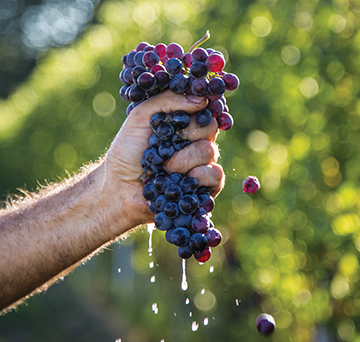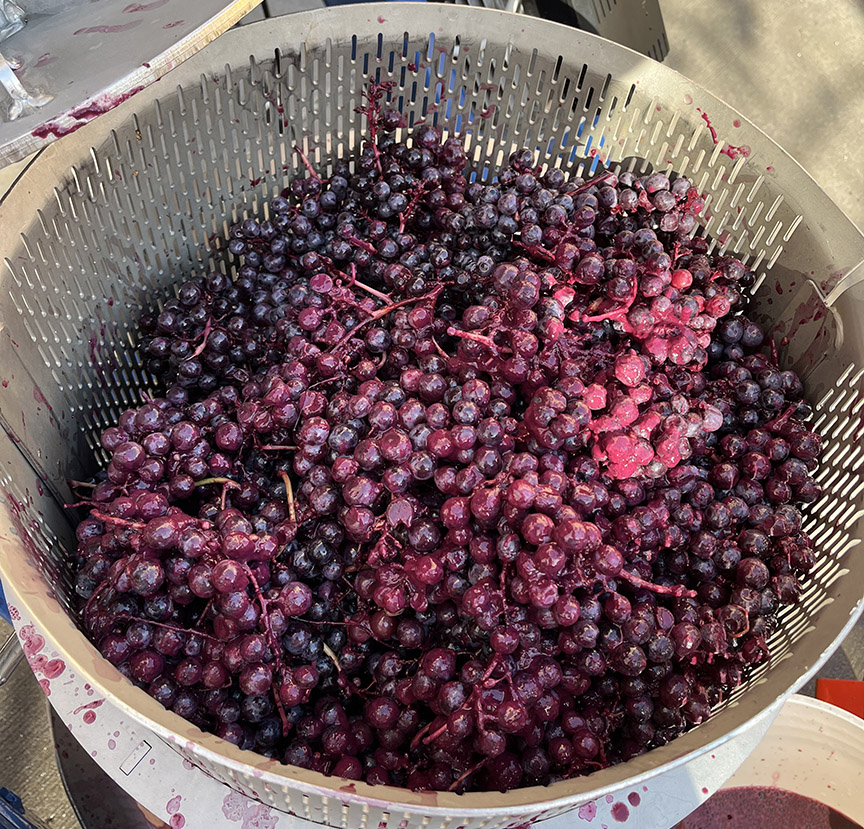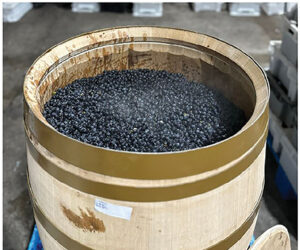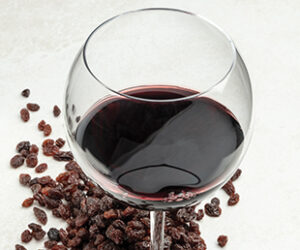
As we hurtle forward into our AI-enhanced, digitally rendered, high-technology future, some people yearn for a return to the simple, traditional ways of the past. In the world of wine consumption this desire for simpler methods and limited additives has spawned ideological fervor in groups like the natural wine movement. Low- or no-intervention winemaking has maintained a popular niche in the world of winemaking, including processing decisions like uninoculated fermentations, limited- or no-sulfite use, and wines packaged without fining or filtration. Another winemaking technique that easily fits this mold of everything old is new again, but which has been embraced by both “conventional” as well as limited intervention winemakers, is whole cluster fermentation. Let’s dive into the research and conventional wisdom on this interesting technique.
What is Whole Cluster Fermentation and How is it Practiced?
Whole cluster fermentation is the fermentation and maceration of hand-harvested clusters that have not been destemmed. This is obviously a red winemaking technique, but could also be employed with white fruit if an orange-style wine is desired. Some winemakers ferment batches with 100% whole cluster fruit, but it is much more common to ferment with some lower percentage of whole cluster (WC) mixed in with destemmed/crushed fruit. A range of 10–50% WC is common, with the remaining percentage being destemmed/crushed berries placed on top of the WC fruit.
Practically speaking, using WC fruit can be a minor processing change if only a small percentage is used. However, when large percentages are used it can make maceration much more difficult if manual punchdowns are performed, and thus may necessitate pouring or pumping over to limit oxidation of the berries on the surface of the ferment. For commercial producers, WC fermentation also means that the grape clusters need to be transferred using forklifts and bins, not pumped.
If you’ve already purchased a destemmer you might ask, “why bother with whole cluster?” The reason is that grape stems contain aroma and tannin molecules that are different from berries and have the potential to increase wine aroma complexity and astringency. In interviews with winemakers, which you can easily find in wine-related media and YouTube channels, as well as this issue’s “Tips from the Pros” column on page 14, you will read or hear them wax poetic on the benefits of stem inclusion. These WC devotees discuss a couple of key benefits. First, a more complex aroma. Instead of the simple fruity aromas of destemmed berries, there are added aromas described as stemmy, herbal, or floral. Winemakers talk about aromas of violets, black tea, forest floor, bitter almond, and pepper spice. Whole cluster Syrah producers also mention an increase in gamey, meaty aromas. An added twist to the aroma complexity of whole cluster is that some winemakers believe leaving the berries on the stem results in some level of carbonic maceration. Carbonic maceration is an enzyme-driven conversion of berry sugars within the intact berry, and results in the production of very fruity aromas.
Another key benefit of WC that winemakers describe is an increase, and sometimes a change in feeling, in the tannic profile of the wine. Comments are made that stem inclusion increases the body of the wine and brings an interesting fullness or roundness to the astringency of the wine, especially for grape varieties that are commonly associated with low tannin levels (e.g., Pinot Noir and French-American hybrids). Finally, winemakers believe that stem inclusion slows down the speed of fermentation, and thus leads to higher tannin levels due to the increased skin and seed contact time prior to pressing. So, the argument for WC fermentation is that the wines made with stem inclusion are more aromatically interesting and contain a more compelling astringent taste profile than wines made with only berries.
There are, however, also some WC detractors, or at least those who recommend proceeding with caution. Even strong supporters of the practice recognize that too many or the wrong kind of stems can throw a wine out of balance, leaving the wine with too much herbal aroma character and/or too high in astringency. Many articles discussing WC fermentation mention the maturity, or lignification, of the stems as an important consideration when determining whether to utilize stem inclusion and at what percentage. The idea here being that green, rubbery stems will extract too much stemmy, herbal aroma into the wine while stiffer, more yellow to brown stems will provide a more positive aroma profile and more pleasant astringency. This leaves us with a somewhat complicated decision analysis for trying to determine whether stem inclusion will benefit a particular wine. Let’s delve into a summary of research results on the topic to see if they correlate to winemaker experience.
Research Insights on Whole Cluster Fermentation
First, a few caveats regarding research into whole cluster fermentation. While there have been some interesting experiments reported in the last 5–10 years, there is not a large body of research on the topic. In addition, sensory research, especially regarding astringency perception, can be difficult to capture in research studies and thus nuances that may be apparent to winemakers may not be present in research results. Also, several studies destemmed all the fruit and then added back a specific weight of stems to the ferments to more easily quantify stem inclusion. Therefore, these studies would not capture the potential impact of carbonic maceration on aroma because the clusters were no longer intact.
In terms of basic wine chemistry, there were not large differences, or sometimes conflicting research outcomes, in the various studies. Ethanol levels were unchanged in most studies, but a few studies reported slightly lower ethanol in WC wines. In several studies the pH was higher, and titratable acidity lower, in wines containing significant quantities of stems. Researchers hypothesized that this difference might be caused by potassium extraction from the stems, which led to increased potassium bitartrate precipitation in the WC wines and thus lower acidity due to the loss of tartaric acid ions from the wine as they form the potassium bitartrate salt. Still, the changes were fairly minor, with a 5–15% drop in titratable acidity and a smaller percentage increase in pH. Some researchers also noted an increase in volatile acidity (VA) in WC wines, which they hypothesized was due to increased oxygen exposure due to stem inclusion. I’m also going to guess that it may be due to cap management and cap mixing being much more difficult with a larger percentage of whole clusters, as I mentioned in the introduction. Inadequate cap mixing can lead to microbial growth on the top of the cap exposed to air, which generate VA compounds.
Wine color and anthocyanin content has been another research focus of whole cluster fermentation, but different papers showed conflicting results. Some studies showed that color levels were lower in whole cluster fermentations, with researchers hypothesizing that the stems were absorbing some of the color released from the skins. Other research showed limited impact on color, or color increasing slightly, especially after aging. The researchers in these studies theorized that the increase in tannin content from the stems was leading to greater color stability because anthocyanins were combining with more tannin polymers to produce polymeric pigment, a more stable form of color than free anthocyanin molecules.
One clear result from whole cluster research is that including at least 50% stems during fermentation will significantly increase the tannin level compared to control wines. When whole cluster inclusion was lower, usually 20–25% stem inclusion in the studies, the tannin content of the WC wines was often not statistically different from control wines, both in terms of sensory perception and analytical measurement of tannins. It may be that a lower percentage of stem inclusion is too subtle to pick up in research studies, but it does show that if you’re really looking for an astringency impact with stem inclusion, you need to shoot for a higher percentage of whole cluster inclusion.
Another clear impact of stem inclusion in research ferments, although a bit more difficult to pinpoint, was the change in aroma. Panelists reported that WC wines were less fruity and more “fresh” than destemmed wines. Some studies mentioned an increase in herbal and “bitter almond” aroma, which I might equate to “stemmy.” Researchers had difficulty pinpointing exactly which aroma volatiles were leading to these herbal and “fresh” aromas, but did find an increase in methoxypyrazines (the class of compounds responsible for bell pepper aroma in Cabernet varieties) in WC wines and hypothesized that a range of compounds responsible for herbal/floral/green aromatics were decreasing the perceived fruit intensity of the WC wines. Several studies mentioned that panelists preferred the aroma and taste of WC wines compared to fully destemmed wines, though this depends on the taster.
One aspect of whole cluster that is difficult to quantify and has been relatively unaddressed in research studies was the “ripeness” or lignification of the stems. One of the studies destemmed the berries and then dried the stems for several days before adding them back to the berries and continuing fermentation. The researchers mentioned that the dried stems seemed to provide less green aromas, an interesting idea for home winemakers, though the feasibility of such a technique may be outside most winemaker’s patience and time constraints during harvest.
In my literature review I also found one study where whole cluster fermentation was performed on hybrid grapes: Frontenac and Marquette. The researchers found similar results to vinifera studies and recommended whole cluster fermentation for Marquette specifically, as a method of increasing the tannin content in wines made from this variety. From my own experience making Marquette wines with students in Cornell University’s viticulture and enology program, the wines made from this variety could clearly benefit from more astringency and it also wouldn’t hurt if the acidity of Marquette wines were reduced by including stems in the fermentation. In addition, Marquette contains so much color that a small color loss would be trivial.
My Own Foray into Whole Cluster Fermentation

I have never utilized whole cluster fermentation in my previous winemaking experience so I thought it would be interesting to try it this past year. As luck would have it there was a little Cabernet Franc from our research vineyard that was not going to be used for another project, so I fermented two small lots (9–12 gallons/34–45 L), one completely destemmed and the other with 50% whole cluster grapes. This mini experiment is far from a research study, which would have a more defined harvest protocol and triplicate batches of each style, but still I found some interesting sensory differences in the two wines that generally lined up with research and anecdotal reports. When I harvested the grapes the rachis tissue (the main backbone of the cluster) was still green. I chewed on the stem tissue and found it to be quite astringent but not overly green or herbal in flavor. This was a good year for ripeness in New York’s Finger Lakes where I live, so by chance I think I picked a good year to attempt stem inclusion. Since I hadn’t performed whole cluster ferments in the past, I can’t say if stem aromas always line up with berry ripeness in my region. In cold years we often smell bell pepper aromas in completely destemmed Cabernet Franc, so in cool vintages stem inclusion could exacerbate the herbal notes already present in this grape. I’ll have to chew on more stems in future years to gain more experience in stem lignification and ripeness assessment.
Cap management during the whole cluster fermentation was much more difficult than the completely destemmed fruit. I performed both fermentations in 20-gallon (76-L) food-grade trash cans, with manual punchdowns twice a day. The 50% WC fermentation was very difficult to manually punch down, and I noticed some VA/oxidation aromas in the top of the must prior to active fermentation. Also, as mentioned earlier, active fermentation took longer to ramp up with the 50% WC trial and the whole fermentation took about a week longer than the completely destemmed trial. I think the cap would have benefited from a pump or pour over of juice from the bottom of the tank, which was impractical with my small-scale setup.
The destemmed wine had a very fruity aroma after fermentation, like cooked cherries, but was a bit one-
dimensional in terms of aroma. The wine was also thin in body and the tannins felt a little harsh in astringency (though not out of the ordinary for a young red wine). The 50% whole cluster wine was much less fruity. There were some cherry aroma notes that were similar to the destemmed wine, but also a mix of stemmy, floral, and slightly minty aromas. I also found the body, or weight, of this wine to be much fuller and more mouth-filling than the completely destemmed wine.
Although to me the level of astringency felt similar between the two wines, the astringent feeling was more rounded and pleasing in the 50% WC ferment. It made me wonder if the change in my astringency perception between the two wines was due to a change in the level or size of the tannin polymers, or due to an interaction between the tannin level and the body in the wines. I also noticed during pressing of the 50% WC wine that there were still a fair number of intact berries connected to the cluster. I tasted some of these berries and they had a very fruity flavor, indicating there may be some truth to the idea of carbonic maceration occurring in a portion of the berries when they are left on the cluster.
After primary fermentation, I sent the wines out for acid and tannin analysis. The two wines had almost the same pH and titratable acidity, but the 50% WC wine contained about 10% more tannin and color than the completely destemmed wine. Given the differences between the two wines from an aroma and astringency perspective, it would also be interesting to try some blending experiments to determine if one could achieve the best of both worlds in terms of fruit, aroma complexity, and tannin expression. Of course, a winemaker could also try to achieve a similar result by adjusting the percentage of whole clusters used in a specific lot.
Many winemakers mention that whole cluster wines continue to evolve in cellar from an astringency and aroma perspective. I tasted the wines again, about two months after harvest, and the differences in aroma and body/astringency between the wines were about the same as when I tasted them right after fermentation. The 50% WC wine was not as fruity as the destemmed wine but had a much more appealing body and astringent taste profile. I’m excited to follow my little experiment through aging and taste the results with my students in the future.
Summary of Whole Cluster Fermentation
Whole cluster fermentation adds flavor and tannin found in grape stems to the winemaker’s toolbox. Whole cluster is most suited to wines that would benefit from additional aroma complexity and enhanced astringency.
To achieve a result that is easy to distinguish from a completely destemmed/crushed ferment it is probably necessary to employ at least 25–50 percent, or more, whole clusters. However, 100 percent whole cluster fermentations can be difficult to manage from a practical perspective, particularly for home winemakers, and may increase the susceptibility of the fermentation to microbial spoilage and oxidation.
Too many or “unripe” stems may also result in overextraction of herbal aromas and an unbalanced bitter/astringent taste, so splitting lots and experimentation is probably the best way to determine if whole cluster is going to be beneficial, and what percentage of whole cluster seems to offer the best balance.
Including whole clusters is more work than common modern production practices, but if the winemaker can make a more interesting wine by including stems in the ferment, then I think the added work is justified by what results in the glass.
References:
1. Blackford, Marie, et al. “A Review on Stems Composition and Their Impact on Wine Quality.” Molecules (Basel, Switzerland), vol. 26, no. 5, Feb. 2021, p. 1240. PubMed, www.doi.org/10.3390/molecules26051240
2. Casassa, L. Federico, et al. “Whole Cluster and Dried Stem Additions’ Effects on Chemical and Sensory Properties of Pinot Noir Wines over Two Vintages.” American Journal of Enology and Viticulture, vol. 72, no. 1, Jan. 2021, pp. 21–35. www.doi.org/10.5344/ajev.2020.20037
3. Gapinski, Alexander D., et al. “Effect of Whole Cluster Fermentation on Phenolics in Cold-Hardy Hybrid Wines.” Food and Bioprocess Technology, vol. 16, no. 7, July 2023, pp. 1595–608. Springer Link, www.doi.org/10.1007/s11947-023-03010-7







